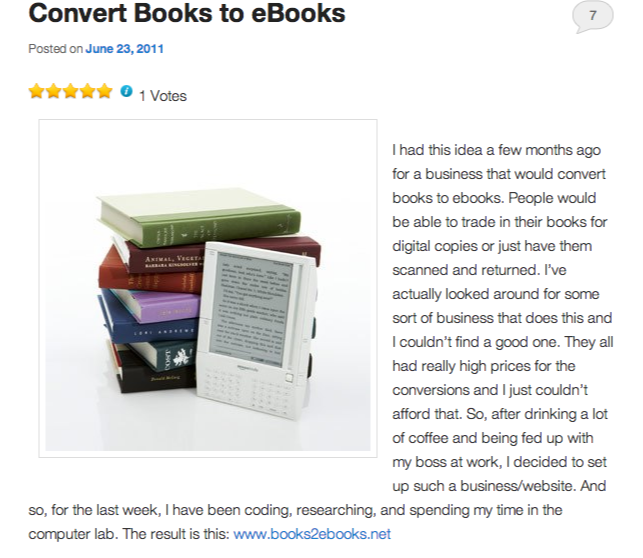The summer before my sophomore year of college, I had this “great” business idea. Looking back, it was kind of silly, but hey, that’s how we learn. I recognized that as Kindles were becoming more popular, people would end up having to re-purchase any physical books that they had in their library in order to own them on their digital device.
Wouldn’t it be great if there was a service out there that converted your physical books into digital ebooks? Basically, you would send in your books to the company, I would scan your physical books, and then provide you with the digital copy (PDF or ebook format).
Suddenly possessed by this idea, I spent about three days hacking together a website called Books2eBooks.net, with the mission of “digitizing your library.”
The website was very simple. I used a free website CSS template that I found online and a WuFoo form to process orders. There were only 3 or 4 pages to the site. To launch the site, I wrote an article on my blog and made a proud facebook post. I’ve included a screenshot of the blog post below that I wrote.
This may be one of the few examples where the “build it and they will come” mentality actually worked, but I had also been blogging for about 3 years sporadically and the keywords “convert books to ebooks” had almost no google results, so my blog post quickly went to the top of the list.
I hosted the website on a free server, so my only expense was the time it took to setup and my domain name. At the time, I reported it being as $7 per year. I also put some Adsense on the website.
So What Happened?
Slowly, the messages started trickling in. People were actually finding my blog post and clicking through. I started getting comments and people started asking about the service. I’ve included a few messages below:
Example 1
“Can books be converted to a form that can then be read using a iPod Touch, iPhone, or iPad? I use my iPod Touch as an e reader and I would like to be able to convert some of the books from my library to a form that could be read on my iPod. Thank you!”
Example 2
“Thanks very much for offering this great product and for supporting such a great cause. I am very interested in using your services but I have a quick question (the FAQ page seems to be down, so apologies if this is something you’ve covered).
Do you make any guarantees about the quality of the scan? I’ve been through this process many times myself and have found that it takes substantial copyediting after a book is scanned to make sure it’s publishable. Do you go through to make sure the text hasn’t been distorted or it that the customer’s responsibility?”
Example 3
“Can you convert any book of any size? And is it always $8 per book conversion no matter the size? If it is a book that I wrote – can you send it to me in a format that would work on Amazon’s self publishing format?”
Here I was, replying to people with a college .edu address, and I had no idea how to actually fulfill these orders. I rationalized at the time that I needed to price below what ebooks were selling for, which was around $10-15, so my conversion price for one book was $8.
When I looked around, other book scanners were charging $20-30 for a single book. I didn’t understand why people would pay for that if an ebook costed less, so I kept with my pricing model.
Had I given myself some time to think over the idea, I would have realized that it takes about an hour to actually scan one book. True, once you scan a book, you don’t have to scan it again, but the likelihood that there were going to be repeats were slim and would only occur if I started getting massive orders. That would be a problem in of itself.
I ended up getting a few hundred dollars worth of orders in the next few weeks. Many people wanted multiple books in their library scanned, so the numbers were adding up quickly.
Unfortunately, I realized that unless I was going to try to hire someone from China or India to fill these orders, when I took into account shipping, labor, and overhead, there was no way I was going to be able to execute on my promise to convert people’s libraries into digital ebook copies and turn a profit. I could make more money at a minimum wage job or internship. I also didn’t have the money to invest in a professional book scanner like the ones that many of the other companies were using.
So, I set up an auto-responder saying that the website was going out of business. I left the website up, and funny enough, it ended up making about $30 that year through adsense, so I came out on top from my original investment of $7 (haha).
Lessons Learned
Startup Marketing
Looking back, it’s kind of astounding I was able to generate such good conversions and traffic from a single blog post. It was pure dumb luck. In all of my entrepreneurial ventures, I’ve always found content marketing to be the top way to market my products/startup ideas. It’s cheap, there is a low barrier to entry, and I’ve always liked writing anyway.
The thing was the book scanners at the time weren’t doing any kind of content marketing and they were using technical terms to describe their business. Not knowing about book scanning, I used terms in the title of my article (and domain name) that I myself would have searched for on google, which ended up working well.
What’s funny also is how you don’t need to get everything right to get some traction. For instance, in example 2, the one customer mentioned the FAQ not working, but still wanted to buy!
Action Item: Spend a good hour on google browsing around. What keywords are not “taken” that customers may use to find your startup product?
Planning
Yes, it was kind of dumb launching a website without a plan. I could have easily done the math in my head (or sample scanned one book) to figure out whether or not the venture was viable. In addition, I could have also done more competition research beforehand. I discovered several competitors after launching the website.
At the same time, if I had done all of that research, I wouldn’t have launched the business and had the realization that I can drive traffic and interact with real customers online.
Action Item: If you can launch a minimum viable product in less than a week, act on your instincts. If it’s going to take months and lots of dough to get a product out there, do your planning. Don’t forget, sometime’s it’s actually good to just launch products as a learning experience.
Failure
Failure isn’t really that bad. Failure is just something not going as you expect. I took an action and it had a certain result. I didn’t take anyone’s money, so no one was angry at me. It was a pretty good risk-free learning experience. Since my financial investment was paltry, I didn’t feel any kind of loss. In fact, I was invigorated because I had gotten some “traction.”
Action Item: Take actions. Examine the results. Fine tune the actions. Keep repeating until the results are what you want them to be. Eventually, you might not have a sustainable business, but you will get some traction, which is empowering!
What Would I Do Over?
This was my first real venture. I didn’t get into entrepreneurship until the summer before my sophomore year. I took action and was lucky to get some traction on the first try.
The problem was, after I took some action, I didn’t keep trying things out when I had the traction. If I could go back in time, I would have tried out different pricing models to see if people would pay higher rates that might make the business sustainable, even though I believed they wouldn’t pay those rates.
I could have also added in other services to be able to raise the rates like charge more for a copy on different types of devices or offer a rebate if they complete some task after 30 days (rebates are many times forgotten by shoppers).
Action Item: Try something out in the real world with real customers, but once you get a result, keep trying things with those customers!
Questions?
Shoot me a message on Twitter or add a comment below.

